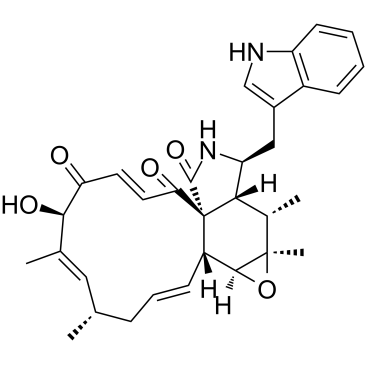Electrospray ionization tandem mass spectrometry of chaetoglobosins.
Guo-Bo Xu, Li-Mei Li, Dong-Mei Fang, Guo-You Li, Guo-Lin Zhang, Zhi-Jun Wu
文献索引:Rapid Commun. Mass Spectrom. 26(18) , 2115-22, (2012)
全文:HTML全文
摘要
Chaetoglobosins are a family of macrocyclic polyketide alkaloids. They possess many similar isomers and exhibit a wide range of biological activities. Thus, there is a need for reliable, fast, and low-cost analysis of this class of compounds.A series of seven chaetoglobosins from Chaetomium globosum, including two types of isomers, were investigated using electrospray ionization quadrupole time-of-flight tandem mass spectrometry (ESI-QTOF-MS/MS) in both positive- and negative-ion mode. The identity of major product ions was supported by deuterium-labeling experiments.In positive-ion mode, the product ion at m/z 130 is the characteristic ion of the indolyl group. A McLafferty rearrangement might play a significant role in the fragmentation of the macrocycle moiety for most chaetoglobosins and produces two series of characteristic product ions, accompanied by neutral losses. The characteristic product ion at m/z 309 in the MS/MS spectrum of chaetoglobosins E indicates the structure of the cyclic olefinic bond in ring B and can be used to distinguish it from the isomers, chaetoglobosins F(ex) , which has an exocyclic double bond on ring B. In negative-ion mode, the McLafferty rearrangement has an important role in the fragmentation pattern of the macrocycle. Some high-abundance radical ions were detected. The radical product ion at m/z 138 might differentiate chaetoglobosins F and penochalasin F, isomers which have very similar structures.In summary, complementary information obtained from fragmentation experiments of [M+H](+) and [M-H](-) precursor ions is especially valuable for rapid identification of chaetoglobosins. The high-abundance radical ions in negative-ion mode are also of scientific interest.Copyright © 2012 John Wiley & Sons, Ltd.
相关化合物
| 结构式 | 名称/CAS号 | 分子式 | 全部文献 |
|---|---|---|---|
 |
毛壳球菌素
CAS:50335-03-0 |
C32H36N2O5 |
|
Exploiting the cytoskeletal filaments of neoplastic cells to...
2002-08-01 [Biochim. Biophys. Acta 1846(2) , 599-616, (2014)] |
|
Chaetoglobosin K induces apoptosis and G2 cell cycle arrest ...
2015-01-28 [Cancer Lett. 356(2 Pt B) , 418-33, (2015)] |
|
Chaetoglobosin F, a small molecule compound, possesses immun...
2013-03-01 [Immunobiology 218(3) , 292-302, (2013)] |
|
Protective effect of the natural product, chaetoglobosin K, ...
2008-06-01 [Pharm. Res. 25(6) , 1297-308, (2008)] |
|
Growth and mycotoxin production by Chaetomium globosum.
2007-07-01 [Mycopathologia 164(1) , 49-56, (2007)] |